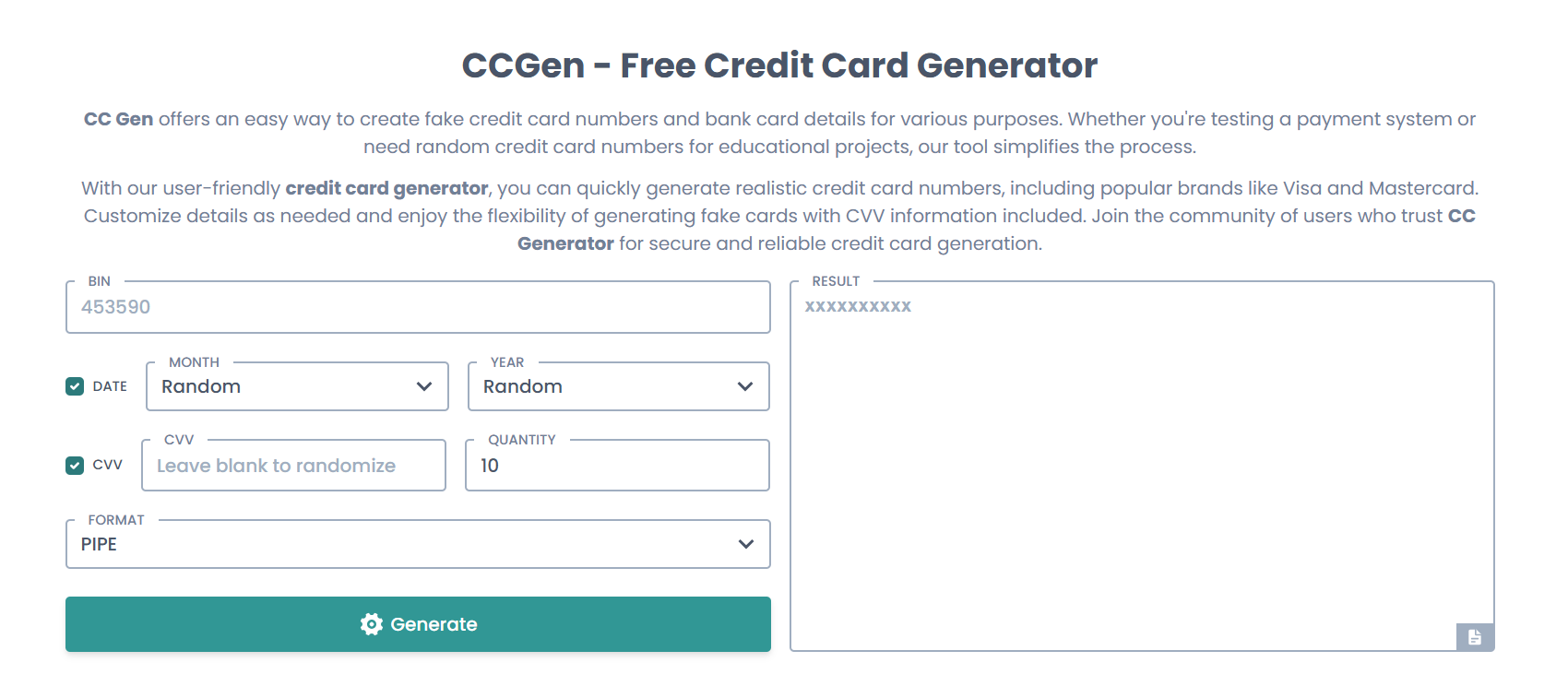Testing payment systems or learning about credit card processing requires realistic but fake data to avoid security risks. CCGen offers a free tool to generate fake credit card numbers that mimic real ones, ensuring complete safety and security. These numbers follow strict validation rules, ensuring they look authentic for testing purposes.
By generating Visa and Mastercard numbers that pass industry checks like the Luhn algorithm, CCGen helps developers, testers, and educators simulate real transaction environments. The tool requires no registration and instantly produces valid-looking numbers, making it accessible and user-friendly.
This guide explains the process CCGen uses to create fake credit card numbers, including the algorithms involved, supported card types, and why this method is essential for safe and effective software testing.
The Basics of Credit Card Number Generation
Understanding Credit Card Number Structure
Credit card numbers are not random; they follow specific formats, including issuer identification numbers, account numbers, and check digits. This structure allows payment systems to identify the card type and validate its authenticity. CCGen replicates these structures to generate realistic numbers for testing.
The Role of the Issuer Identification Number
The first few digits of a card number represent the issuer, such as Visa or Mastercard. These digits determine which payment network processes the card. CCGen uses correct prefixes to ensure generated cards correspond to real issuer patterns, increasing test accuracy.
Importance of the Check Digit
The final digit in a credit card number is a check digit calculated using the Luhn algorithm. This digit verifies the number’s validity and helps detect errors or fraud. CCGen calculates this digit accurately to ensure each generated number passes validation checks.
Algorithms Behind CCGen’s Number Generation
The Luhn Algorithm Explained
The Luhn algorithm is a checksum formula used by banks to validate card numbers. It involves a series of mathematical steps applied to the card digits to verify correctness. CCGen implements this algorithm to produce numbers that appear legitimate during validation, enhancing testing realism.
Random Number Generation and Validation
CCGen randomly generates the body of the credit card number while keeping issuer prefixes fixed. It then calculates the appropriate check digit using the Luhn algorithm. This process is repeated until a valid number is produced, ensuring each card number is structurally sound.
Ensuring Unique and Valid Numbers
To avoid duplicates and maintain test integrity, CCGen’s system generates unique numbers on demand. Each number passes through validation filters before display. This guarantees users receive authentic-looking but fake credit card numbers suitable for varied testing scenarios.
Supported Card Types and Formats
Visa Card Number Format
Visa card numbers typically start with the digit 4 and are 13 to 16 digits long. CCGen respects this structure, generating numbers with correct prefixes and lengths. This ensures compatibility with payment platforms that accept Visa cards for testing.
Mastercard Number Format
Mastercard numbers begin with prefixes ranging from 51 to 55 or 2221 to 2720 and have a length of 16 digits. CCGen accurately generates numbers within these ranges. This supports realistic testing for Mastercard payment integrations.
Potential for Additional Card Types
While CCGen currently focuses on Visa and Mastercard, the underlying algorithms can support more card brands. Expanding to include American Express, Discover, and others is possible, providing wider test data diversity in the future.
CCGen’s Method Is Essential
Accurate Simulation of Payment Processing
By generating card numbers that pass validation algorithms, CCGen allows realistic simulation of payment processing workflows. This helps developers identify errors and optimize their systems before live deployment. Accurate simulation reduces financial and reputational risk.
Safe Testing Without Real Card Data
Using real credit card numbers for testing poses security risks and legal issues. CCGen eliminates this problem by creating fake numbers that cannot be linked to actual accounts. This ensures testing environments remain secure and compliant with privacy laws.
Cost-Effective and Accessible
CCGen’s free, instant generation of valid fake card numbers removes barriers to thorough testing. Developers, educators, and testers save money and time by avoiding costly test cards or paid services. This democratizes access to quality test data.
Step-by-Step Generation Process
Selecting the Card Type
Users start by choosing their desired card brand, such as Visa or Mastercard. This selection sets the appropriate prefixes and formatting rules for the number to be generated. Clear options ensure the user gets tailored test data.
Generating Random Digits
CCGen fills in the remaining digits randomly while respecting length requirements. This randomness ensures each generated card number is unique. The tool prepares the number for the final validation step.
Calculating and Adding the Check Digit
Using the Luhn algorithm, CCGen computes the last digit to complete the number. This digit guarantees that the number will pass standard validation checks. The final output is a fake card number ready for use in testing scenarios.
CCGen’s Generated Numbers
Software and Payment Gateway Testing
Developers use CCGen’s numbers to verify transaction flows and error handling in their software. Fake cards allow them to simulate purchases and refunds safely. This improves application stability before launch.
Educational Use in Learning Environments
Students and instructors use these numbers to explore credit card validation and payment systems. Hands-on practice with realistic data enhances comprehension. It supports a practical approach to finance and programming education.
Security and Fraud Detection Research
Security professionals test systems against fake card data to improve fraud detection algorithms. CCGen numbers provide controlled test cases without exposing real user information. This leads to stronger payment security solutions.
Conclusion
CCGen generates fake credit card numbers by combining issuer-specific prefixes with randomly generated digits, finalized through the Luhn algorithm. This method produces structurally valid, unique numbers ideal for safe testing and education. Supporting Visa and Mastercard formats, CCGen enables realistic payment simulations without risking sensitive data. Its free, user-friendly design helps developers and educators worldwide improve their software and understanding of payment systems effectively.





